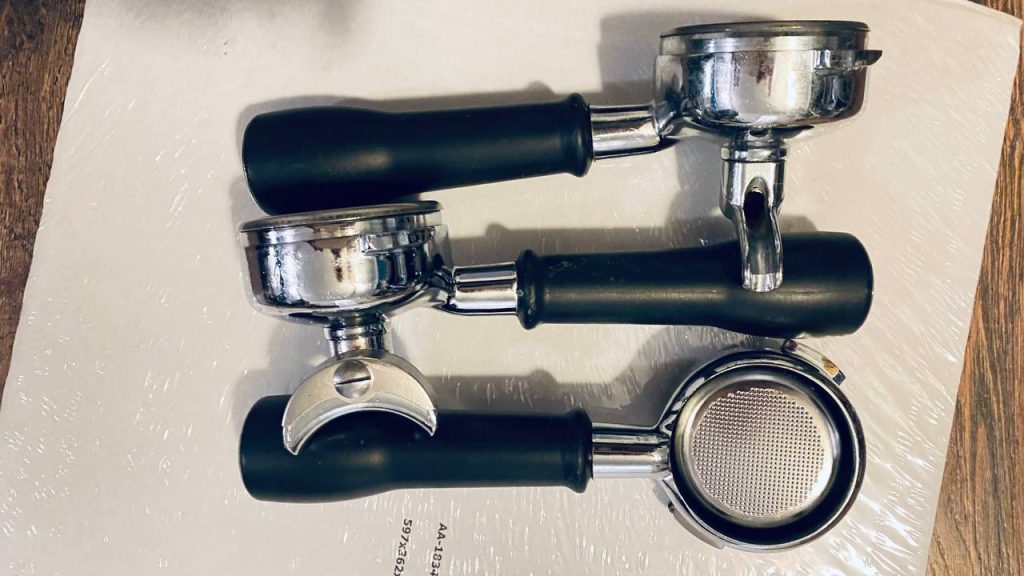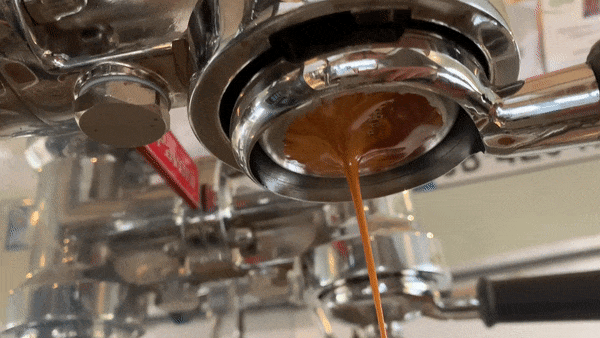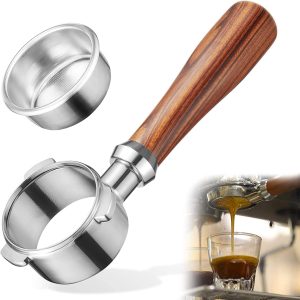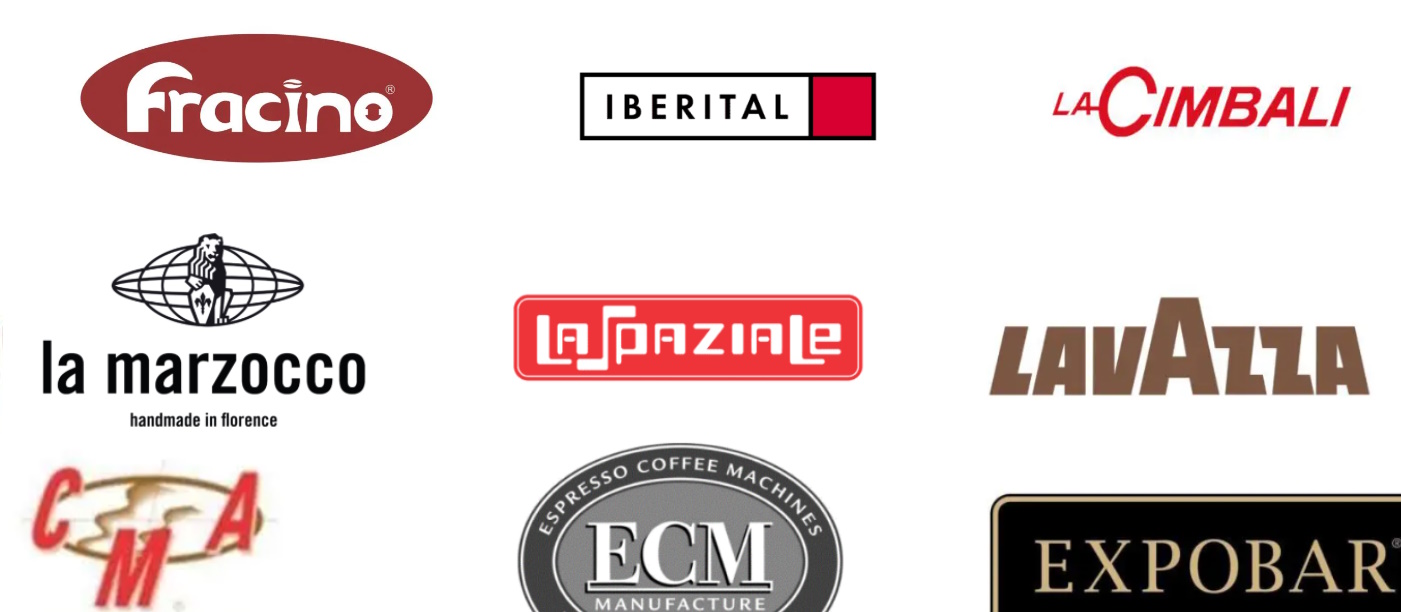If I go into a coffee shop and I see that the barista is using a bottomless portafilter, I know there and then that they know what they are doing, like the name suggests, there is no hiding when using a bottomless portafilter. Some people use the term '‘naked’ portafilter but we mean the same thing; a portafilter without any spouts. We will explain why it’s such an important weapon in the professional (and home) baristas arsenal.

Single Spout Portafilter (top), Double Spout Portafilter (middle), Bottomless Portafilter (bottom)
We have all three types in the van, two bottomless portafilters almost permanently reside in the groupheads, and the double spout on standby in case anyone wants a single shot. The single spout is rendered useless.
What is a Bottomless Portafilter?
The bottomless portafilter is the a specially machined portafilter without the more common double spout on the bottom As you can see below. It A bottomless portafilter is a unique tool in the world of espresso making. The purpose of a bottomless portafilter is to help baristas monitor and improve the quality of the espresso they make. In this article, we'll take a closer look at the history of the bottomless portafilter and its benefits.
History of the Bottomless Portafilter
They haven’t actually always been around, and the invention of them isn’t well documented. But what we do know is the the bottomless portafilter was first introduced some time around the late 1960s and early 1970s. None of the big espresso machine manufacturers have claimed it as their own invention, which is great as we could imagine if it was patented it would not have been as big as it is now!
Why a bottomless portafilter is (almost) always better
The portafilter is essentially just the thing that holds the basket, and we’ve already made a thing of how important a precision basket can be to the coffee making process, but the bottomless portafilter just completely exposes any failures in the coffee preparation. The bottomless portafilter works by removing the bottom of the traditional portafilter, allowing baristas to see the flow of the espresso shot.
This allows the barista to identify if there is an issue with the espresso, as it’s being produced. Where a spouted portafilter hides the the extraction, a bottomless portafilter makes it immediately clear if there is a problem. We have spoken before about extraction times and our coffee making recipes resulting a uniform or predictable espresso. All things being perfect, the espresso should look like the following;

What we are looking for is a mostly even arrival of coffee through the bottom of the basket, with gaps filling in to result in a nice smooth flow of espresso.
Problems a Bottomless Portafilter can help identify
The bottomless portafilter, will have issues such as channelling, which is when water flows through the coffee puck unevenly, leading to an inconsistent extraction. It can help you identify if the coffee is not ground fine enough, the tamp is not even, if the coffee puck is dislodged from the side. Basically anything that could cause the water to moved through the coffee unevenly.
A bottomless portafilter allows you to monitor the quality of the espresso shot in real time. With a traditional solid portafilter, baristas must rely on their senses, such as sight, smell, and taste, to determine the quality of the espresso.
With a bottomless portafilter, baristas can see the flow of the espresso shot and know, without tasting it that the espresso is going to be below standard and not good for the customer. This really helps level up your barista skillset, the ability to see the flow of the espresso shot allows baristas to learn and improve their techniques more quickly.
This can be especially helpful for new baristas who are still learning the craft of espresso making or even just the hobbyist that wants to improve their technique and understand their machines capabilities that bit better. Seeing what’s going on, with every shot, leads to better tasting and more consistent espresso shots, which can lead to a better overall experience for customers, family friends and most importantly, yourself!
Which bottomless portafilter should I get?
It does completely depend on your machine, some of the more premium or prosumer machines will come with one, but sometimes they don’t and are almost always a worthwhile upgrade.
Portafilters for Sage
The best selling machines in the UK are the Sage Bambinos and Barista Expresses, which all use the 54mm portafilter.
DeLonghi or Smeg
If you use a Delonghi Dedica or a SMEG machine then you will be using a 51mm portafilter and you can find a few at that size on Amazon.
Portafilters for Gaggia
Gaggia on the other hand use the commercial size portafilter size of 58mm and you can find bottomless portafilters that fit their Classic, Cubika and Baby ranges as well as some of their more high end machines.
Portafilters for other espresso machines
If you have any other of the wide range of espresso machines out there, there is likely a bottomless portafilter out there waiting for it. Hit up our friends at ShopCoffee, they have a huge range of spare handles and bottomless portafilters.
Final thoughts
In conclusion, the bottomless portafilter is a valuable tool for baristas looking to improve the quality of the espresso they make. With its ability to monitor the flow of the espresso shot and identify any issues, baristas can quickly make adjustments to improve the quality of the espresso. Additionally, the bottomless portafilter can improve training for baristas and lead to a better overall experience for customers. Whether you're a seasoned barista or just starting out, a bottomless portafilter is a tool that can help you make better espresso.





